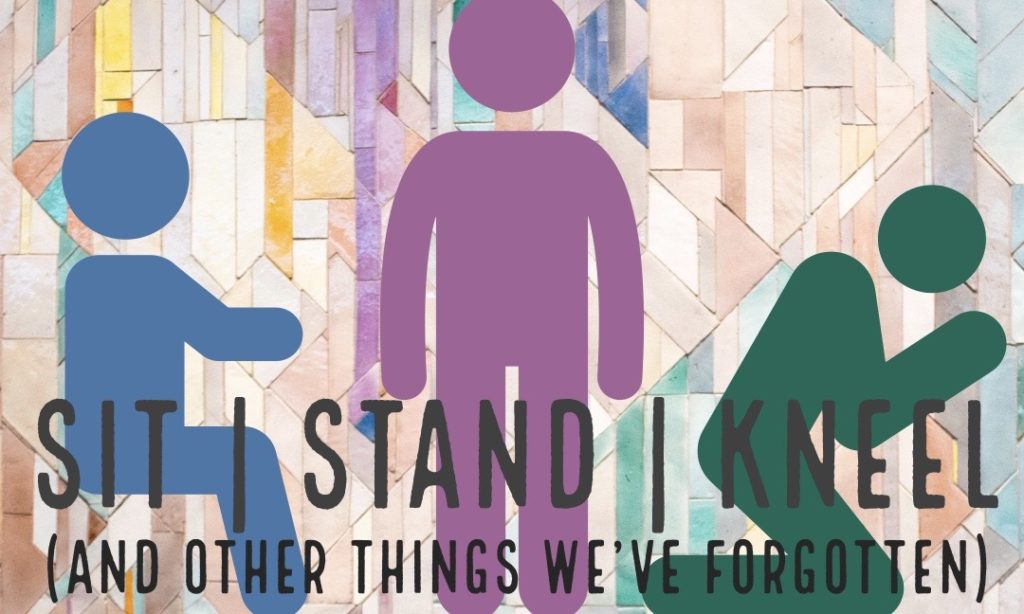Participating in Mass: Home Style
By: Sarah Streitwieser

If your family is anything like mine, you may find that participating in virtual Mass at home is a bit more challenging than participating in Mass when we are actually at church. Remembering to sit, stand, and kneel at all the right times is tricky — particularly when there is no one else to copy! Exactly when do we sit, stand, and kneel? Why are these postures and gestures important? The Ascension Family Life Ministry offers you and your family this quick refresher course!


Standing – We stand as our priests process into the church. Standing is a sign of respect; our priests represent Christ in the celebration of Mass. Standing is also a posture meant to represent the resurrection; we have risen with Christ and seek things from above. The posture of standing also signifies are readiness to respond to God subito, sempre, e con gioia – right away, always, and with joy.
Signing the cross – We begin and end Mass with the sign of the cross, marking the cross of Christ on our own bodies. In doing this, we acknowledge that by Christ’s death and resurrection we are redeemed. When we mark ourselves with the cross of Christ under the names of the Holy Trinity, we place ourselves in the blessing of the resurrection and participate in the call to die to ourselves.


Beating chest three times — During the penitential rite, we beat our chest 3 times during the phrase, “through my fault, through my fault, through my most grievous fault.” This is a sign of repentance and humility, repeated from the account in Luke 18:13.


Sitting — At the conclusion of the Penitential rite, we sit down. This posture demonstrates receptivity and attentive listening. By sitting, we avail ourselves to receive the Word of God in the first two readings and responsorial psalm.
Standing – we stand when our priest or deacon stands to pick up the book of the Gospel from the alter. As stated before, we stand as a sign of respect, as a symbol of our resurrection, and because we are ready to respond.
Tracing Three Crosses – Just before the Gospel is read, we trace 3 small crosses on our foreheads, lips, and hearts. Silently we pray that the Word of God always be in our minds, on our lips, and in our hearts. In this gesture we communicate the death to self and resurrection with Christ implicit in following him with our whole selves.


Folding Hands – We fold our hands while the Gospel is read as a sign of our intimate communion with Christ, experienced most fully through His incarnation, life, death, and resurrection.
Sitting – we sit after the book of the Gospel is placed, open on the front of the Ambo. We sit as a sign of receptivity, as our priest or deacon teaches and applies the Word of God to our lives.
Standing – we stand again for the Creed and for the Prayer of the Faithful. In this posture of resurrection, we lift our prayers to God.


Bowing – during the Nicene Creed, we bow during the phrase, “and by the Holy Spirit, was incarnate of the Virgin Mary.” In this gesture we reverence Christ’s greatest act of love and humility — His incarnation into human flesh.
Sitting —
Typically, there would be an offertory at this time, during which we would sit.
This component of the Mass is skipped while we are unable to gather in person.
Standing – In absence of the offertory, we continue standing until after the Sanctus (what you probably think of as the “Holy, Holy, Holy” prayer). At the words, “Hosanna in the highest,” we kneel.


Kneeling – We kneel for the entire Eucharistic Prayer until after the “Amen.” Kneeling signifies our adoration of Jesus, truly made present in the Blessed Sacrament. Kneeling also demonstrates our submission to Christ, our deepest reverence in prayer, our humility before Christ, and a spirit of penance and repentance. Standing – We stand after the Amen and through the Agnus Dei (What you probably know as the “Lamb
Signing
Peace – Because we are currently unable to gather for Mass,
there is not a pause for sharing the Sign of Peace. For some families with
younger children, the Sign of Peace is a much-loved aspect of Mass! You can
insert your own time for sharing the Sign of Peace after the response, “and
with your spirit.”
Kneeling — we kneel again after the Agnus Dei, through the communion rite, and through the Spiritual Act of Communion prayer offered by our priests on our behalf. During the Spiritual Act of Communion, we seek to unite ourselves spiritually with Christ. We express our sorrow with being separated from Him sacramentally, unite ourselves to Him spiritually, and look forward — with hope – to the day when we will be fully reunited.
Standing – We stand again as our priests process out of the Church. Having been filled with the life and love of the Trinity and of the entire Church gathered spiritually, we are now sent into the world to live what we celebrate.
Printable Guides
All of the same information presented above but in printable format is below (in case you want to use it as a guide during home-Mass)
Do you
remember the first page spread of our hymnals, with the prayers and responses
for Mass written out? If you find yourself or your family members searching to
remember all the words, here is your at-home-hymnal cheat sheet!



